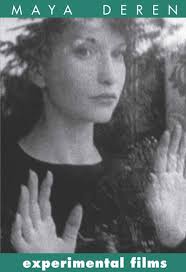
“Meshes of the Afternoon” was released in 1943 and was directed by Maya Deren and Alexander Hammid. It is an experimental film. A sort of avant garde personal film that dealt with devastating psychological problems and was filmed much like the French surrealist films of the 1920s such as Salvador Dalí and Luis Buñuel's "Un Chien Andalou" (1929) and "L'Age d'Or" (1930). The film was shot in black and white.
The movie is basically a series of images. A flower is placed on a street or walkway by a disembodied hand and arm. A woman’s shadow (Maya Deren) reaches for the flower and then her hand comes on screen and picks it up. She then sees someone on the street as she is walking back to her home. She unlocks her door with a key and sits in a chair. She falls asleep.
She dreams of trying to catch up to a hooded person walking down the walkway. Whenever the person's head turns toward her their face is a mirror. She repeatedly tries to catch up to the figure and repeatedly ends up entering her home. Other objects appear over again. A key, a knife, a flower, the ocean, a telephone, a record player. All shown at different angles and in different sequences and in many little motifs. She goes upstairs and sees the hooded mirror faced person put the knife under a pillow. She sees herself try to kill her sleeping body.
A man (Alexander Hammid) appears and wakes her. He goes upstairs. She follows him. She sees him put the knife under a pillow the same way the mirror person did. She tries to kill the man but it ends up being a mirror and the pieces fall into the ocean.
The man comes home and opens the door with his key. He finds the woman dead in the chair.
Although not necessarily a silent film only one word is spoken. The budget of the film is estimated to be about $300.
Freud and Jung freaks are all over this with interpretations and attempts to decode the symbolism and of course the hidden sexual meaning. Deren objected to the film being under such scrutiny. According to her, the objects in the film were just objects and didn’t have any more hidden meaning then what their actual function was in the film as a whole. In other words, a key is a key, a knife is a knife and a phone is a phone.
I wasn’t sure if they were trying to express homicide or suicide or if it was real or psychological. But then it’s one of those avant garde surreal things so I could be totally wrong. The film is only about fourteen minutes long so it’s OK if you have to watch it twice to try to figure out what’s going on. And good luck with that.
In 1990, Meshes of the Afternoon was selected for preservation in the United States National Film Registry by the Library of Congress as being "culturally, historically, or aesthetically significant".

